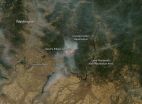(Press-News.org) A team of clinician researchers has discovered a highly virulent, multidrug resistant form of the pathogen, Pseudomonas aeruginosa, in patient samples in Ohio. Their investigation suggests that the particular genetic element involved, which is still rare in the United States, has been spreading heretofore unnoticed, and that surveillance is urgently needed. The research is published ahead of print in Antimicrobial Agents and Chemotherapy.
The P. aeruginosa contained a gene for a drug resistant enzyme called a metallo beta-lactamase. Beta-lactamases enable broad-spectrum resistance to beta-lactam antibiotics, including carbapenems, cephalosporins, and penicillins, because they can break the four atom beta-lactam ring, a critical component of these antibiotics' structure.
The initial isolate of metallo-beta-lactamase-producing P. aeruginosa was identified in March, 2012, in a foot wound of a 69-year-old man with type 2 diabetes living in a long-term care facility. During 2012-2013, the investigators identified this highly antibiotic-resistant infection in six other patients. One of the seven patients subsequently died of the infection.
The cases are linked epidemiologically via admission to a community hospital and residence in long-term care facilities in Northeast Ohio. The one exception was a patient from Qatar who was transferred into a tertiary medical center in Ohio, says lead author Federico Perez, of the Louis Stokes Cleveland Department of Veterans Affairs Medical Center, Cleveland, Ohio, USA.
The investigators subsequently found that the metallo beta-lactamase was contained within an integron, a genetic element that can jump from one species of bacterium to another, can reside on plasmids or within the chromosomes, and is known for being able to contain multiple antibiotic resistance genes.
This particular metallo beta-lactamase, verona integron-encoded metallo beta-lactamse (VIM), is widespread globally, if not in the US. "VIM enzymes confer resistance to imipenem and all other beta-lactams," says Perez. "They are not inhibited by metallo beta-lactamase inhibitors."
"Alarmingly, the [extensively drug-resistant] phenotype expressed by some of these isolates precluded any reliable antibiotic treatment since they even displayed intermediate resistance to colistin, an 'agent of last resort'," the researchers write. "Patients who were affected had multiple comorbidities, endured prolonged colonization, required long-term care and, in one instance had a lethal outcome from a bloodstream infection."
On top of everything else, genomic sequencing and assembly showed that the integron was part of a novel 35 kilobase region that included a transposon (another mobile genetic element) and the so-called Salmonella Genomic Island 2 (SGI2). That indicated that a recombination event had occurred between Salmonella and P. aeruginosa, contributing even more resistance genes to the latter.
"This is the first description of genetic exchange of a large mobile element—the Salmonella Genome Island—and resistance genes between P. aerugenosa and Salmonella, says Perez. "This movement of genetic material creates concern that metallo beta-lactamases will disseminate rapidly in these enteric pathogens that are also very invasive. We are also concerned about the possibility of enhanced virulence."
INFORMATION:
The manuscript can be found online at http://bit.ly/asmtip0814a. The final version of the article is scheduled for the October 2014 issue of Antimicrobial Agents and Chemotherapy.
Antimicrobial Agents and Chemotherapy is a publication of the American Society for Microbiology (ASM). The ASM is the largest single life science society, composed of over 39,000 scientists and health professionals. Its mission is to advance the microbiological sciences as a vehicle for understanding life processes and to apply and communicate this knowledge for the improvement of health and environmental and economic well-being worldwide.
Highly drug resistant, virulent strain of Pseudomonas aeruginosa arises in Ohio
2014-08-11
ELSE PRESS RELEASES FROM THIS DATE:
Want to kill creativity of women in teams? Fire up the competition
2014-08-11
Recent research has suggested that women play better with others in small working groups, and that adding women to a group is a surefire way to boost team collaboration and creativity.
But a new study from Washington University in St. Louis finds that this is only true when women work on teams that aren't competing against each other. Force teams to go head to head and the benefits of a female approach evaporate.
"Intergroup competition is a double-edged sword that ultimately provides an advantage to groups and units composed predominantly or exclusively of men, while ...
New study: Ravens rule Idaho's artificial roosts
2014-08-11
A new study by the Wildlife Conservation Society (WCS), U.S. Geological Survey (USGS) and Idaho State University (ISU) explored how habitat alterations, including the addition of energy transmission towers, affect avian predators nesting in sagebrush landscapes.
Researchers compared nesting habitat selection between Common Ravens and three raptor species commonly found in sagebrush ecosystems: Red-tailed Hawks, Swainson's Hawks, and Ferruginous Hawks.
Using the data from their field research and reviewing historical data from other studies, the scientists developed ...
Can fiction stories make us more empathetic?
2014-08-11
Empathy is important for navigating complex social situations, and is considered a highly desirable trait. Raymond Mar, a psychologist at York University in Canada, discussed how exposure to narrative fiction may improve our ability to understand what other people are thinking or feeling in his session at the American Psychological Association's 122nd Annual Convention.
Exposure to stories
Many stories are about people--their mental states, their relationships—even stories with inanimate objects, may have human-like characteristics. Mar explains that we understand stories ...
Julio embarking on weakening trend
2014-08-11
The Central Pacific Hurricane Center has issued its 30th warning on Julio today at 1500 GMT. Julio's position at this point is 395 miles northeast of Honolulu, Hawaii moving northwest at 8 knots per hour. Julio is moving toward the northwest near 9 mph, 15 km/h. Maximum sustained winds are near 75 mph, 120 km/h, with higher gusts. Julio is expected to weaken slightly over the next 48 hours, down to tropical storm strength by tonight.
At present, hurricane force winds extend outward up to 25 miles, 35 km, from the center, and tropical storm force winds extend outward ...
Genevieve Downgraded to a tropical storm
2014-08-11
Once Super Typhoon Genevieve has now been downgraded to a tropical storm. The storm is located approximately 819 nautical miles west-northwest of Midway Island. It is currently tracking northwestward at 8 knots per hour over the past six hours. Maximum significant wave height is 32 feet. Maximum sustained winds 70 knots gusting to 85 knots, with winds of 34 knots or higher occur within 80 to 105 miles of the cente,r and winds of 64 knots or higher occur within 15 miles of the center. No landmasses are currently threatened by this storm.
Genevieve is moving northwest ...
Southfork and Staley Complex fires in Oregon
2014-08-11
The Southfork Complex fire began with a lightning strike on July 31, 2014. The complex of Murderers Creek South fire and the Buck Fork fire is located 20 miles southwest of John Day, Oregon and has affected 62,476 acres to date. The fire area experienced a shift in direction of the prevailing winds Sunday. There were short up-slope, up-canyon runs. At present there are 798 personnel fighting this fire complex.
Projected outlook for this fire complex in the next twelve hours sees continued fire spread to to the north toward Dayville, Oregon as well as continued fire ...
Devil's Elbow Complex in Washington state
2014-08-11
The Devil's Elbow Complex is four wildfires that are located on the Colville Indian Reservation in northeastern Washington. They were detected on August 3, but were likely ignited by lightning that passed through the area on August 2.
Three fires are in the San Poil River Valley, approximately 10-12 miles north of the town of Keller, WA. These are the Cub Creek Fire (165), the Central Peak Fire (160), and the Deadhorse Fire (164). They are burning timber, grass, brush, litter, and heavy slash that resulted from a local wind storm two years ago. The terrain is very steep ...
Synthetic molecule makes cancer self-destruct
2014-08-11
Researchers from The University of Texas at Austin and five other institutions have created a molecule that can cause cancer cells to self-destruct by ferrying sodium and chloride ions into the cancer cells.
These synthetic ion transporters, described this week in the journal Nature Chemistry, confirm a two-decades-old hypothesis that could point the way to new anticancer drugs while also benefitting patients with cystic fibrosis.
Synthetic ion transporters have been created before, but this is the first time researchers have shown them working in a real biological ...
NIST therapy for ultraviolet laser beams: Hydrogen-treated fibers
2014-08-11
To make a better optical fiber for transmitting laser beams, the first idea that comes to mind is probably not a nice long hydrogen bath.
And yet, scientists have known for years that hydrogen can alter the performance of optical fibers, which are often used to transmit or even generate laser light in optical devices. Researchers at the National Institute of Standards and Technology (NIST) have put this hydrogen "cure" to practical use, making optical fibers that transmit stable, high-power ultraviolet laser light for hundreds of hours. NIST scientists expect these hydrogen-treated ...
Stanford researchers uncover cancer-causing mechanism behind powerful human oncogene
2014-08-11
A protein present at high levels in more than half of all human cancers drives cell growth by blocking the expression of just a handful of genes involved in DNA packaging and cell death, according to a new study by researchers at the Stanford University School of Medicine.
The researchers found that the protein, called Myc, works through a tiny regulatory molecule called a microRNA to suppress the genes' expression. It marks the first time that a subset of Myc-controlled genes has been identified as critical players in the protein's cancer-causing function, and suggests ...






